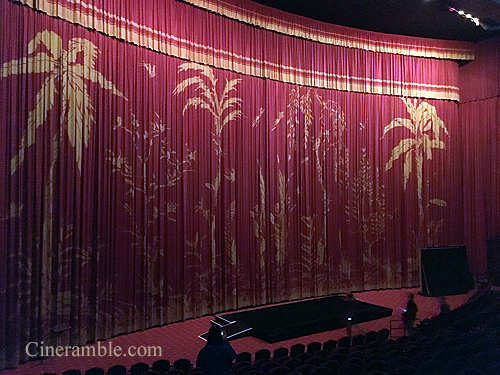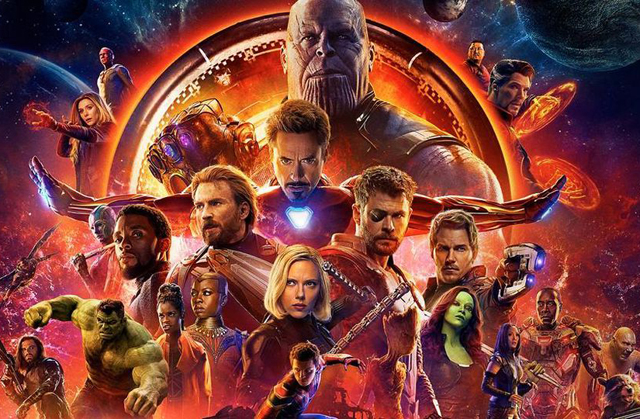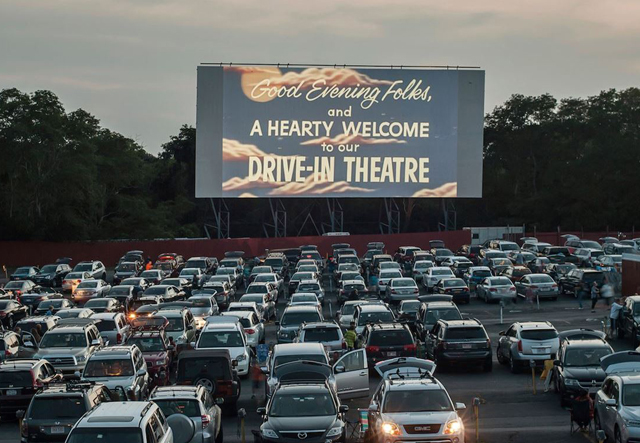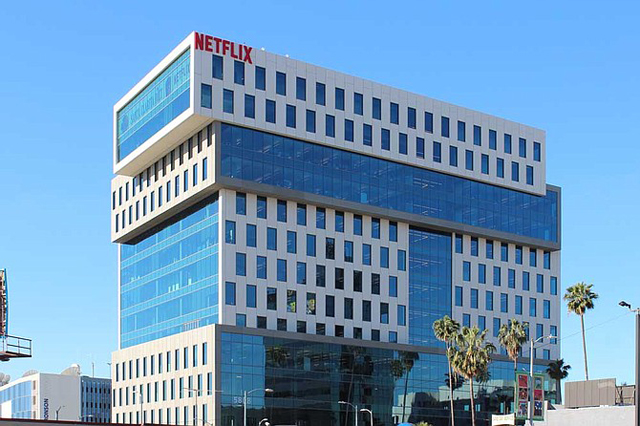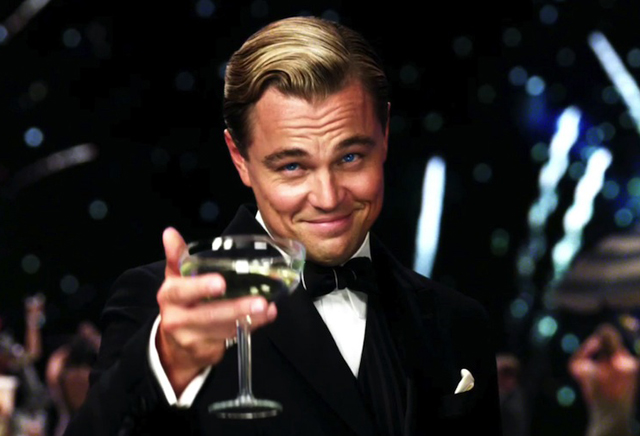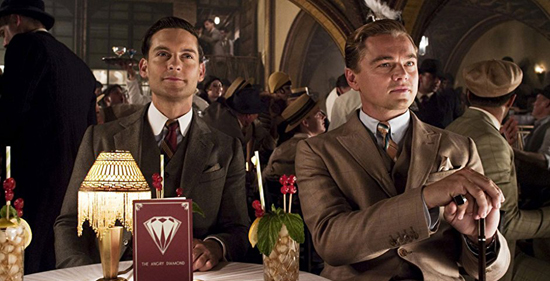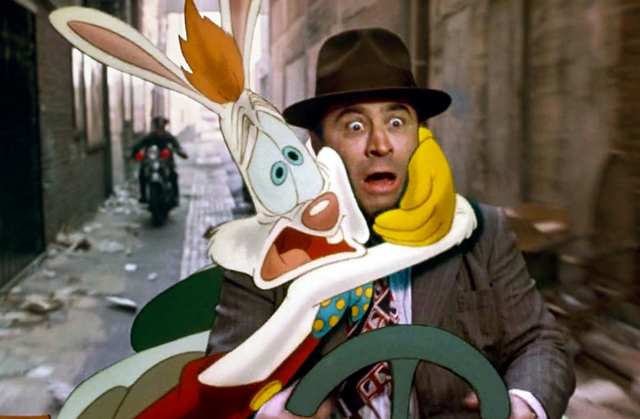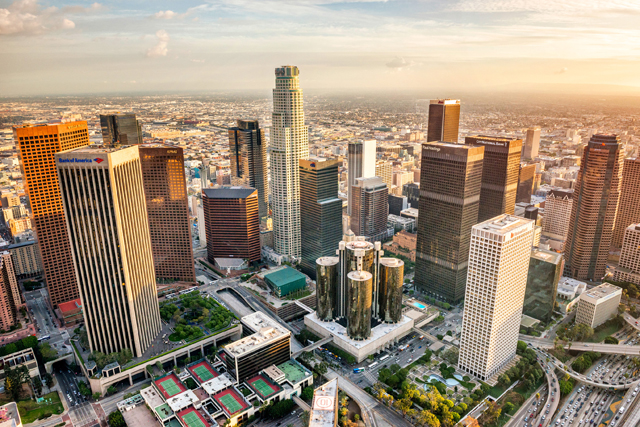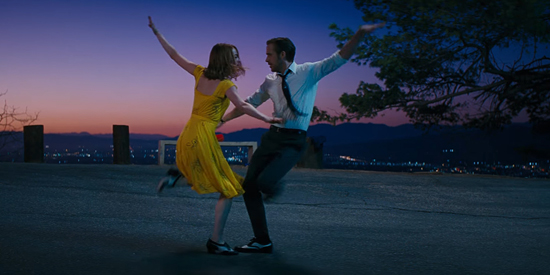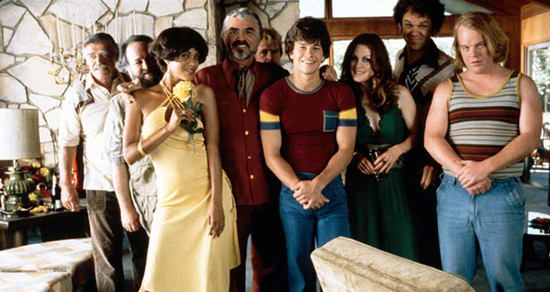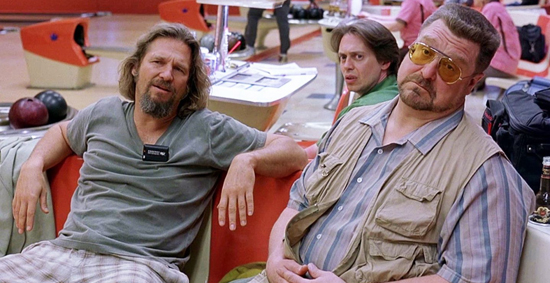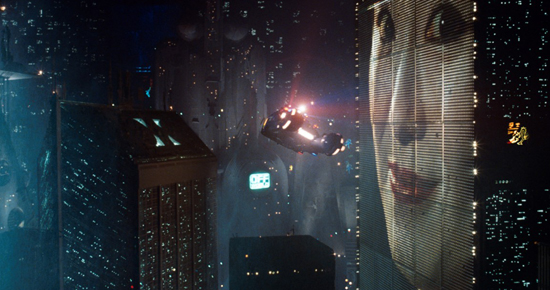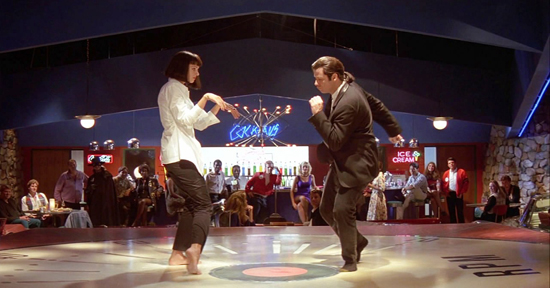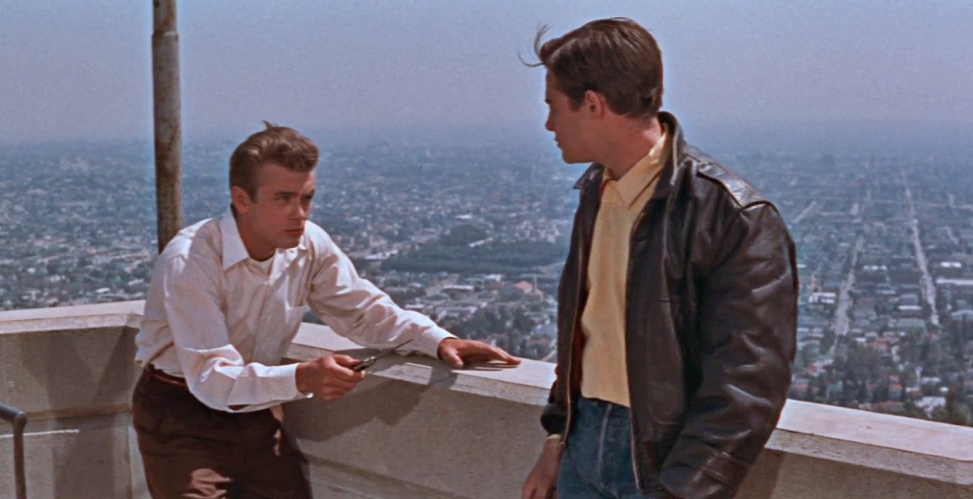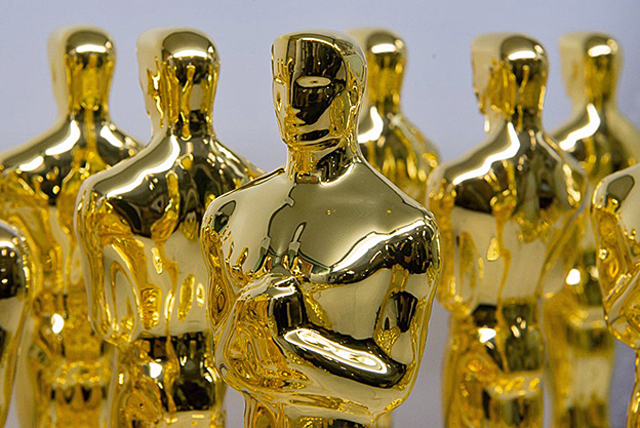
There are a lot of things that I love about living in the City of Angels called Los Angeles, but chief among them is the fact that I live only a stones throw away from the heart of Hollywood. Hollywood of course is not definitively one singular place here in the Southland, but an industry spread across the whole city. But when one refers to a place named Hollywood itself, it is often used to describe the stretch of road called Hollywood Boulevard between the intersections of Vine Street and Highland Avenue. This is where you will find the world famous Walk of Fame which continues to draw tourists from across the globe. And then of course, you have the legendary movie palaces of the El Captain, the Egyptian, the Cinerama Dome and the Chinese, which are probably the most famous movie theaters in the entire world. World premieres are held in these venues, a tradition that dates back to cinema’s early days and continues up to right now. They also have in recent years become the home to an annual event that helps to celebrate the wonder that is cinema in the place where it was born. Turner Classic Movies (TCM) has over the last decade made their Classic Film Festival a special treat for those of us living and working in Los Angeles, giving us the opportunity to watch legendary and classic movies the way they were intended to be seen, on the big screen, and also be given the extra pleasure of hearing from the people involved with their making as special guests. This year has been my 7th overall and 5th that I have covered for this blog, and every year I manage to improve my overall experience at the festival. I’m attending more movies, planning my days out better so that I don’t miss the ones that I want to see, and checking off a lot more titles off the list of classic movies that I haven’t watched yet.
This year, I had to adjust a lot more of my planned schedule due to some unfortunate timing. With Marvel’s early release of Avengers: Infinity War last week, I had to miss the opening night events in order to watch that movie instead so I could write my review. Because of this, everything on this blog has been pushed back a week, including my full report of this festival. It’s likely that I wouldn’t have seen much on the Thursday night opening of the festival anyway. They had a special award ceremony in the Chinese Theater that was exclusive only to special passholders and invited guests, both of which I was not one of. This new award is called the Robert Osborne Award, named after the longtime host and face of the Turner Classic Movies channel who sadly passed away last year. The Osborne Award is intended to honor artists and filmmakers who have left a significant mark on the industry and are dedicated to preserving the treasures of cinema’s past with their work and advocacy. Naturally, the first ever recipient for this award is noted cinephile and master filmmaker Martin Scorsese, who was there to accept the honor, introduced by Leonardo DiCaprio. Despite not being there at this event, I have watched Martin Scorsese’s acceptance speech online, and it’s one that already has stirred up some debate as the famed director took a few shots at websites like Rottentomatoes.com, stating that they’ve negatively affected the industry by turning films into rated products rather than art that’s looking to be discovered. the same opening night also included a 50th anniversary screening of The Producers, with director Mel Brooks in attendance. I don’t feel too bad about missing out on this, considering that I’ve seen Brooks twice at this festival in previous years. So, despite missing opening night, I did make the most out of the rest of the festival, and that is what I’ll be sharing with you right now.

FRIDAY APRIL 27, 2018
Because I work a regular job in the morning, I wasn’t able to make my way to Hollywood Boulevard until after 5:00pm. After a quick rush to use the city’s transit system, I managed to arrive at the Chinese Multiplex in the Hollywood & Highland Center (also the home of the Oscar venue, Dolby Theater) where I got in line for my first film of the festival. It was a screening of the classic Universal Studio’s monster flick, Creature from the Black Lagoon (1945), with the added treat of being presented in it’s original 3D presentation. Unlike the original two strip 3D process, which required red and blue glasses to get the full effect, this screening of Creature was given a digital makeover, allowing for current 3D technology to make the film both pristine and up to date. Unfortunately, even despite arriving with enough time to spare, the event staff had a hard time filling all the available seats. I did manage to get in, but it was very late into the presentation. Basically, I sat down as the movie was running, with the opening credits already complete. I missed the entire opening presentation, which was conducted by comedian and radio host Dennis Miller, who is an avid fan of these classic monster movies. Despite being disappointed by missing the opening, I did see most of the film itself, which was a first time for me. It was really neat to see a classic film shown in 3D, as early films in the process liked to show off the technique a lot more than most modern day films do. The underwater photography in particular really holds up in the 3D process. A screening like this is something that only a festival like TCM’s can make available to the public, as classic 3D movies are hard to find nowadays, especially on the big screen. Thankfully, missing the opening for this presentation was the only time this would happen for the rest of the festival for me.

Upon exiting the film, I managed to get immediately in line for the late night showing in the Chinese Theater, which would end up being something that would end up continuing for me for the rest of the festival. This night included a screening of the classic horror movie The Exorcist (1973), with director William Friedkin in attendance. Despite the long standby line that I stood in, I was able to make it into the theater and got a pretty decent seat as it turns out. TCM host Ben Mankiewicz welcomed director Friedkin to the stage with a warm round of applause from the audience. Despite there being chairs on stage for a sit down interview, the energetic Friedkin refused to take a seat, feeling much more comfortable standing on stage, even despite admitting that he had a cracked rib from a prior injury. Mankiewicz and Friedkin began talking about the movie’s making in general, and connected it with the recent premiere of the director’s new documentary, The Devil and Father Amorth (2017), which covers the same subject matter as The Exorcist. They also talked about the unorthodox casting of playwright Jason Miller in the role of Father Karras, as well as the inspired casting of classic film actress Mercedes McCambridge as the voice of the demon. Afterwards the discussion was opened up to people in the audience. The one thing that stuck me about this presentation is that William Friedkin likes to talk. You give him a question, he’ll give you a twenty minute answer. And yet, none of us were bothered by that because everything he shared, from the casting choices to the decision to use “Tubular Bells” as part of the soundtrack was fascinating to listen to.

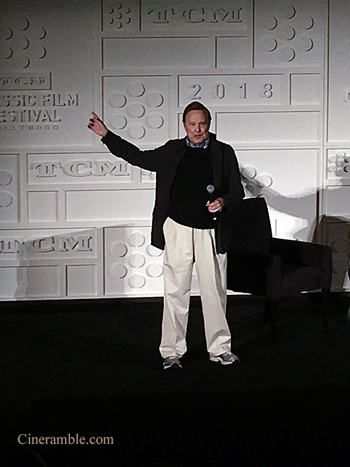
Perhaps the highlight of this discussion was after one audience member asked Friedkin if there was any truth to an urban legend about the movie. Apparently, an extra in The Exorcist named Paul Bateson, who plays a radiologist’s assistant in the film, went on to become a real life serial killer in the years after. This is an already known fact, but audience member wanted to know if the rumor was true that this real life serial killer ended up being the inspiration for the serial killer in Friedkin’s later film Cruising (1980), starring Al Pacino. Mankiewicz interjected immediately, believing that this was purely an urban legend and that Friedkin’s answer was going to be a definitive no. But, then the director, to Ben’s surprise, actually went on to confirm that it was true. The look on Mankiewicz’s face when Friedkin said this was priceless. From that, Friedkin went on to detail how he actually approached Bateson, after he had been caught and convicted, by visiting him at Rikers Island and interviewing him about the details of the murder. And those interviews with a real life serial killer, who Friedkin had been in contact with before through The Exorcist, did provide the backbone of the murders portrayed in Cruising so many years later, and Bateson was indeed an un-credited consultant for the film, confirmed by the director himself. It’s fascinating revelations like that which make these discussions before the movie so worth it. Friedkin talked for a full hour before the movie even started, but despite making the night longer than expected, it was still worth it. I’ve seen The Exorcist before, but watching it on a big screen made the experience even more special, and it made my first night of the festival very rewarding.
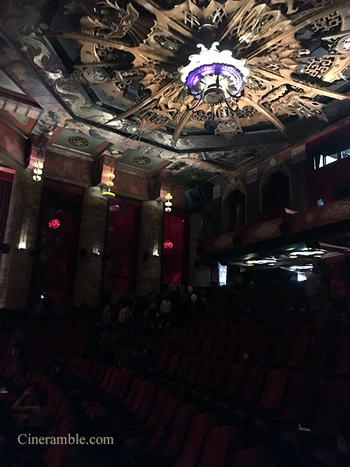
SATURDAY APRIL 28, 2018
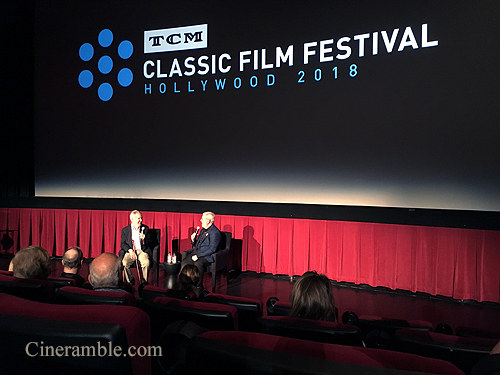
Because the previous night went long (The Exorcist didn’t finish until nearly 1 am in the morning) I slept in past the first run of movies presented in the early morning. One that I wished I had seen was a presentation at the Cinerama Dome on Sunset Boulevard called Windjammer: The Voyage of the Christian Radich (1958), which apparently was the one and only film ever shot in the short-lived widescreen process called “Cinemiracle” which was similar to the Cinerama process that the Dome was built to present. I’ve watched movies in the Dome before, but never one in the Cinerama process, so I missed yet another opportunity here. But, I was already on little sleep to begin with, so I had to make a choice to rest up for the rest of the festival. My first choice for this second day was to go to the Chinese again for a screening of the Steve McQueen classic, Bullitt (1968). Unfortunately, the movie sold out even before they began to let standby patrons in, so even though I got there on time, I was out of luck. This would thankfully be the one and only time that would happen this year. I quickly made my way to the multiplex upstairs, where the next available movie was being played, which was Kramer vs. Kramer (1979), the Oscar winning film from Robert Benton starring Dustin Hoffman and Meryl Streep, which was about divorce, single parenthood, and custody battles in the late 70’s. Director Benton was there as a special guest, interviewed by critic Leonard Maltin. Because I came to the movie late, I only caught the tail end of their pre show interview, but thankfully, they would return after the show for more.
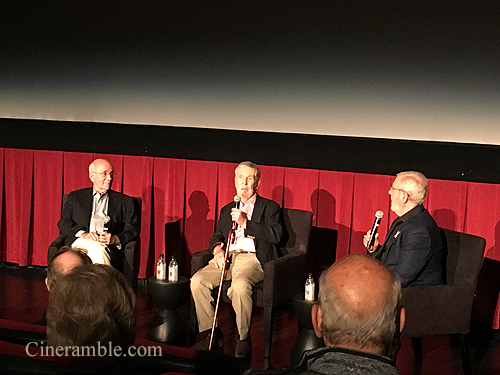

Both Maltin and Benton stayed to watch the movie with us, and afterwards an emotional Leonard clearly was very touched having seen the movie in it’s entirety again after a very long time. They arrived up front to talk more about the movie and were joined by producer Stanley Jaffe. They discussed the decisions in adapting the Avery Corman novel to the big screen, which resulted in a more even handed portrayal of the divorce between the two leads in the film, making Streep’s character a bit more sympathetic than she is in the book. They also discussed Robert Benton’s approach as a director, which Leonard Maltin described as capturing “moments” rather than directing a plot. In the film, it’s clear that Benton took a much more hands off approach, allowing his actors to play out their scenes naturally instead of drawing attention to the fact that they are performing for the camera. This results in a movie that has a much more natural, real life quality to it. They also talked about how crucial it was to find the right young actor to play the pivotal role of Billy Kramer, the child at the center of the story, and how they land on the casting of then 7 year old Justin Henry, who is still to this day the youngest nominee ever for an Oscar. It was an informative discussion and helped to make up for me missing the first half of it prior. The movie still plays well after nearly 40 years, and the audience, like Leonard Maltin, was still moved by it’s story. So, after this, I immediately made my way outside the multiplex to wait in line for the next movie in the same exact theater as the last one.
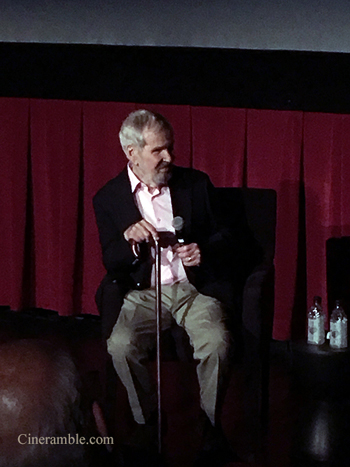
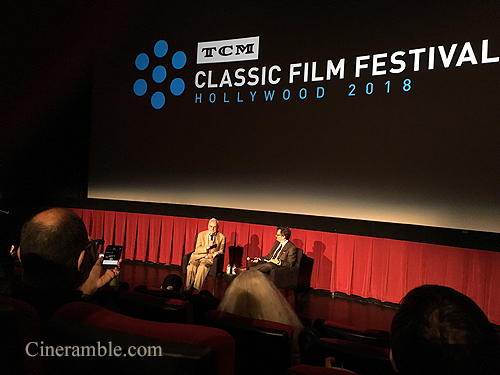
After a break of about an hour, in which I got a quick lunch, I entered the theater for my next film, which was the groundbreaking Merchant Ivory classic Maurice (1987). Though not as widely known as many of the other movies at the festival, and certainly not the most heralded of the Merchant Ivory films either, Maurice was actually the best new discovery that I left an impression on me at this festival. I hadn’t seen this one before, but having watched it now and on the big screen, I was struck by just how relevant this movie continues to be even 30 years later, and how it plays in a different context today than it did back when it first premiered. The main reason why I wanted to go to this screening, however, was to see director James Ivory in attendance before the movie. 89 year old Ivory recently made history becoming the oldest Oscar winner ever for his screenplay for the movie Call Me by Your Name (2017), and his work on that script was no doubt influenced by his work on this film, which was called attention to in the interview with Ben Mankiewicz. Ivory discussed how they took a chance adapting E. M. Foster’s controversial novel about gay romance in Edwardian England in the middle of the peak of the AIDS crisis across the world. In a time when homosexuality was still a taboo during the 1980’s, this positive portrayal of a sexually repressed young man at the turn of the century coming to terms and embracing his sexuality was a bold project to undertake, especially after James Ivory and producer Ismail Merchant’s internationally successful A Room with a View (1985). The movie has a frankness about it’s subject matter that still makes the movie as prescient as ever, and it was interesting to hear James Ivory’s perspective on the film’s legacy.

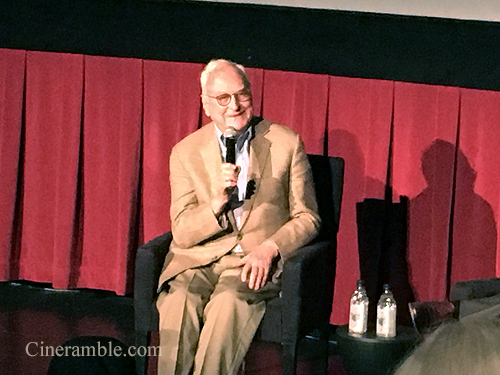
What’s even more pleasing is that even at nearly 90 years, Ivory is still not slowing down. He is already working on another screenplay for director Alexander Payne and he plans on trying to get back behind the director’s chair once again, this time for an adaptation of Shakespeare’s Richard II. He also thought it was interesting how both Maurice and Call Me By Your Name work together as a dual package of queer themed movies. He observed that one is a tragic story of pain that concludes with a happy ending and the other is a happy story of love that has a bittersweet finale. In a way, he is grateful that time has made some things better for LGBT people, and that movie’s like Maurice may have had some positive influence in changing the culture, but he also stressed that there is still a lot more that can and should be done to achieve full equality. It was a very rewarding experience hearing from the director himself, and I found the movie very touching as well. Though the Merchant Ivory style isn’t exactly what I typically go for, I still found it’s portrayal of a young man’s discovery of his sexual identity in such a repressive culture very relateable and affecting. I wonder if it’s actually time for this movie to gain a new revival after Ivory’s success at the Oscars, because this is a movie worth rediscovering. The fact that there is even a scene where the main character goes through a type of conversion therapy (which features a cameo from Ben Kingsley as the therapist) makes the movie feel sadly all too timely as well, as so-called therapy is still being used to “fix” a person’s sexual identity today, despite it being debunked as junk science. I’m very glad I made the time to catch this one at the festival and it’ll probably be a movie I revisit again in the future.
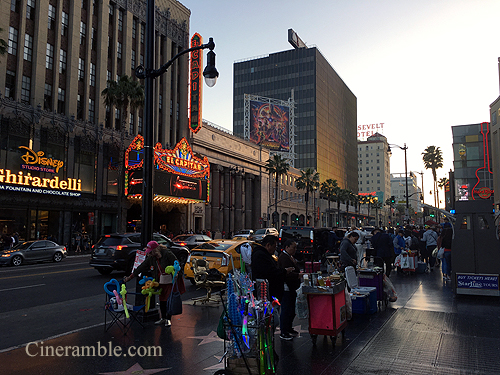
I decided to skip the next round of movies so that I could get a prime seat for the final film of the night at the Chinese Theater. This was going to be a 20th Anniversary screening of the Coen Brother’s classic comedy The Big Lebowski (1998). After Maurice, it was a four hour gap in between, in which I passed over other movies like Heaven Can Wait (1978), The Lost Weekend (1945), and silent comedy Show People (1928) which played with a live orchestra. And the reason why I took this long of a break was because I did not want to miss Lebowski, mainly because they were going to have the “Dude” himself, Jeff Bridges, there as the special guest. Thankfully the planning worked out and I got in without worry. Apparently, I didn’t need to take special measures because everyone got in regardless if they were in standby or if they had a pass. The theater was packed for this one still, and even though I’ve already watched Lebowski a dozen times already, I have never watched it on a big screen before. Ben Mankiewicz arrived to open the discussion, and he stated that after speaking with Bridges backstage, he believed it was better to just toss aside his notes for the interview. And sure enough, once Jeff was on stage, the entire program became a much more free-wheeling talk between the two. Bridges even started things off with a moment of meditation with the entire audience. You knew that the moment that he walked on stage that we were about to have a fun time.
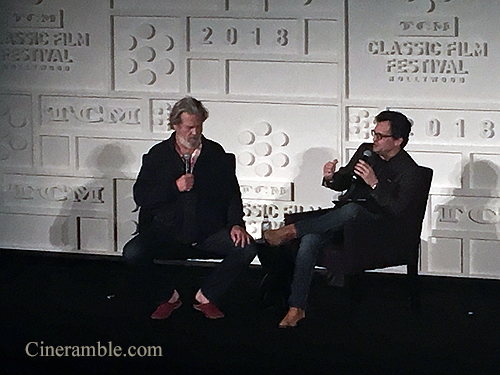
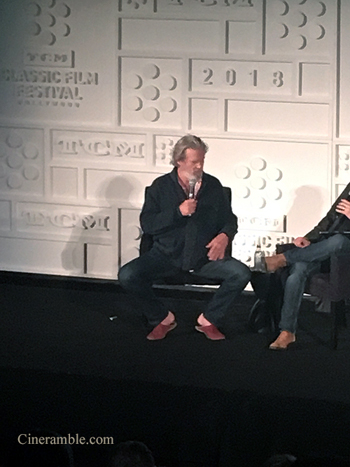
He talked about the inspirations that influenced the persona of the “Dude”, which he acknowledges is one of his favorite roles. An interesting tidbit is that the famous slacker wardrobe, like the sweater and the clear plastic sandals, were actually clothing articles that Jeff actually owned, meaning he is responsible alone for crafting the look of the character. He talked a lot about working with the Coen Brothers as well as with his co-star John Goodman, whose character was heavily influenced by maverick filmmaker John Milius. He also fondly looks over the legacy that the movie has left behind, noting how he loves to visit the annual Lebowski Fest, where he sees so many people dressing up like characters from the film, including as he mentioned someone dressed like the sketch that Jackie Treehorn scribbles in the film. After the interview, he said he would stay and watch the film with us, because he hadn’t seen the whole thing since the film’s premiere. Grateful for the reception, he left the stage and the movie began. It was a whole different experience watching this with an audience, because every time a classic moment would happen or a popular character would show up, the audience would erupt in jubulent laughter and applause. The movie is still funny after 20 years, and even the passage of time hasn’t diluted it one bit. Combined with the pre show interview and the big screen presentation, this was the highlight of the festival so far for me. Only one full day left after this, and it would be a big one too.
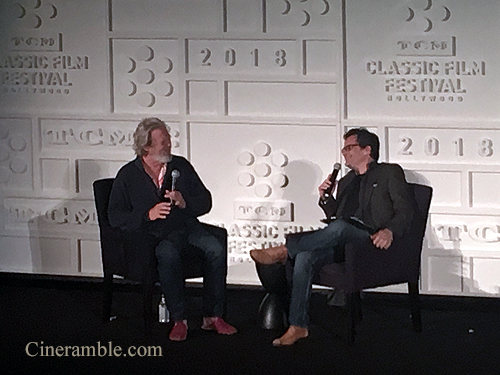
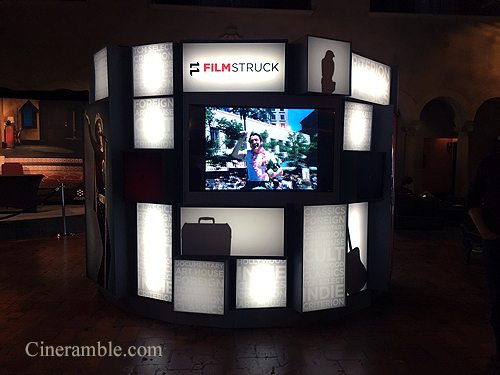
SUNDAY APRIL 29, 2018
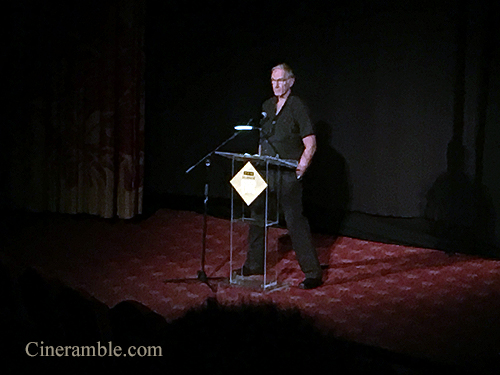
I started early this morning to make it to the Chinese Theater in time for a 9:15 am screening of Sergio Leone’s Once Upon a Time in the West (1968). After two long days before, catching a nearly three hour Spaghetti Western in the early morning was going to be an endurance test for me with the minimal amount of sleep I had gotten each day. Thankfully, I did make it through and managed to watch this Leone classic for the first time all the way through, all the more rewarding given that it was on the giant Chinese theater screen. The film was introduced by director John Sayles, himself a filmmaker of some modern day revisionist Westerns like Lone Star (1996). He wasn’t interviewed, but instead gave us the audience a background history on the movie we were about to watch. He detailed the fact that this was Leone’s first ever film backed by a major Hollywood studio (Paramount) after so many years working within the Italian film industry. He also pointed out that because of movies like this, an extreme close up of an actor’s eyes has been given the term the “Italian Close-up.” The movie, while sluggish at times, was neat to watch on the big screen, especially with it’s beautiful widescreen panoramas and the iconic Ennio Morricone score. Afterwards, I quickly went to the cineplex to watch Frank Capra’s classic Mr. Smith Goes to Washington (1939), another movie I had never watched the whole way through. I arrived just before the movie started. Thankfully there was no pre-show interview, but instead an introduction from a TCM host, so my last minute arrival didn’t make me miss much. For a first time viewing, it was interesting to see this movie with knowledge of our current political climate. While hokey and a little naive at times, it’s still inspiring to watch Jimmy Stewart’s passionate performance in this film, and makes you wish that a figure like him still existed in politics today.
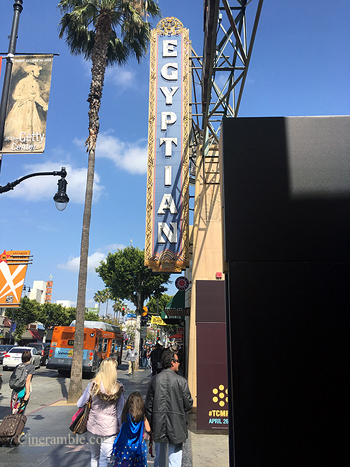
After my two films in the early morning, I made my way over to the Egyptian, which would surprisingly be my one and only time at this venue this year. Past years, I usually caught one film a day here, but considering there were so many that I wanted to watch at the Chinese this year, this was the only time I could fit in a movie at this venue. The Egyptian has become a special venue for this festival, because it is now the only one equipped to present movies in original film prints. Over the course of the festival, the theater presented movies in everything from 70mm, to 35mm, to the extremely volatile Nitrate prints. Though also equipped for digital presentations, the festival has made the Egyptian entirely their film print theater. Thus, this was also my one and only time to see a movie that was actually film running through a projector. For this showing, I managed to watch the film Bull Durham, again another first time for me. In attendance was director Ron Shelton and also a previously unannounced guest, actor Tim Robbins. Interviewed by Ben Mankiewicz, Shelton and Robbins were asked about the different life influences that they brought with them into the movie. Shelton himself was a minor league ball player before he got into film-making, so the movie clearly is semi-autobiographical in a way. Robbins talked about how he was a right handed actor who had to learn how to throw left-handed, which led to Ron and Ben making the joke that he’s a “right-handed lefty,” kidding him of course about Robbins outspoken political views. Mankiewicz also joked if it was difficult to get Susan Sarandon to act like she was attracted to Robbins in the movie, and Robbins replied saying that the movie resulted in three children with Sarandon, his real life partner, whom he met on this film.
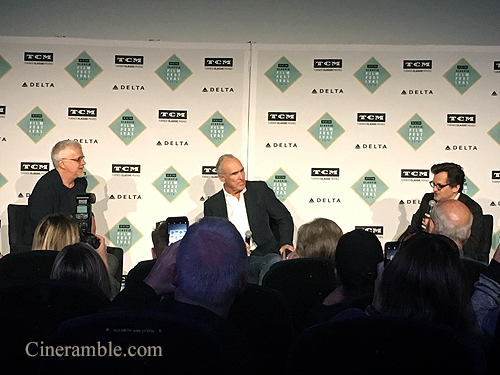
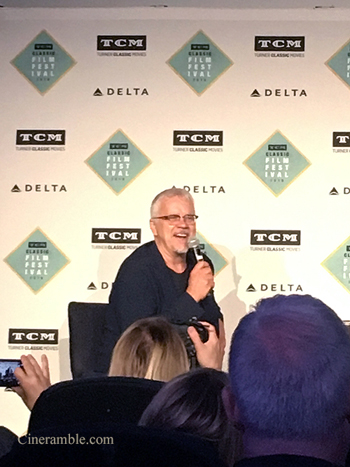
Ron Shelton also talked about the difficulties of shooting the movie on location in Durham, North Carolina. Apparently, the film was shot in the middle of Winter, despite it taking place in the Summer, and Shelton points out that he had his actors chew ice before each take in order to minimize the visible breathe vapors that would have shown up on film in the cold nights they were shooting in. Both men are clearly proud of their work on the film and are happy that it still holds up after thirty years. Having never seen it before, I was happy that my first experience was with actual film projected on a big screen. Film just has a different texture to it, and helps to give the movie an aged quality that enriches the experience. I’m not that into sports movies in general, and I wouldn’t exactly say that Bull Durham converted me over either. I still enjoyed the movie, especially every moment with Kevin Costner on screen, who really makes the film entertaining with his snarky character. Sadly, I would have to miss out on catching the last Nitrate screening of the festival, something which was a highlight for me at last years fest, because I had to conclude my festival this year over at the Chinese. For the last big show of the night, TCM was setting us up for their biggest gathering yet, with a 40th anniversary screening of National Lampoon’s Animal House (1978).

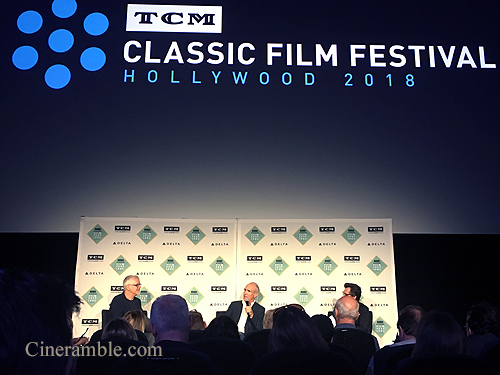

This was clearly intended to be a major reunion for much of the cast and crew. In attendance were director John Landis, executive producer Sean Daniel, actress Martha Smith, songwriter Stephen Bishop, and actors Tim Matheson, Bruce McGill, Jamie Widdoes and Mark Metcalf. Being a long time fan of this movie, this was a screening I did not want to miss, especially with all these people in attendance. Not only do I think it’s one of the funniest movies ever made, but the film holds a special place for me because it was shot in my hometown of Eugene, Oregon. Using the University of Oregon as the setting for the fictional Faber College, the film is one of only a handful of films ever shot in Eugene, and easily the most famous, and just watching it again is kind of like a short little homecoming for me. I was clearly not the only one in the audience from Oregon, as the mention of Eugene, nearby Cottage Grove and the University in Ben Mankiewicz’s intro brought a cheer from some people in the crowd (myself included). Ben also scored some points with me by responding to the cheer by adding “Yeah, Go Ducks.” Afterwards, the large group of guests were brought on stage, easily the biggest of the whole festival. John Landis led the charge for most of the discussion, talking at length about the many hurdles it took to get the movie made by the very skeptical studio execs at Universal. Apparently, Landis passed over Chevy Chase and Dan Ackroyd in some of the lead roles, in favor of fresher faces, and only wanted to keep John Belushi out of the cast members coming from Saturday Night Live.
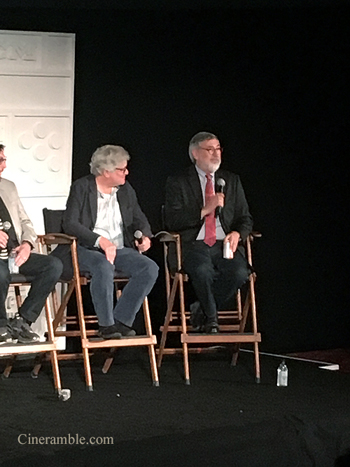
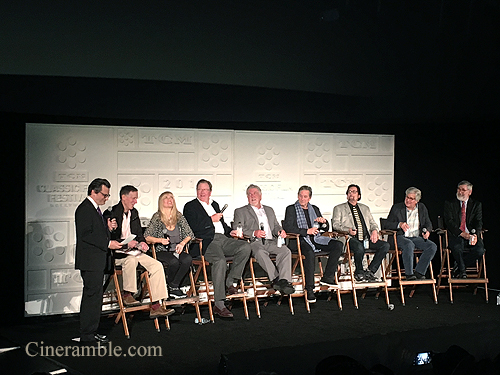
Some of the best stories though revolved around the many tumultuous encounters that the cast had filming on the Oregon campus, including numerous fights started with students in the local fraternities. They also talked about working with Belushi and also the recently departed Stephen Furst, whose widow was also there in the audience and was given a special mention. Casting of established actors like Donald Sutherland and John Vernon was also talked about, and it was interesting that they had the full confidence of Vernon from the very beginning, who was not like the stuffy character he plays in the film and believed from day one that this raunchy comedy was going to be a hit, giving the troubled production a much needed seal of approval. They also talked about shooting the climatic parade scene in Cottage Grove, Oregon, which Mankiewicz pointed out to the classic film loving crowd was also where Buster Keaton had filmed his classic, The General, all the way back in 1927. In addition to the often hilarious stories (including one where Bruce McGill stole a piano and brought it to his hotel room), singer Stephen Bishop even performed the two songs he contributed to the film; the title song in the credits as well as the ballad he actually sings in person in the film before John Belushi takes his guitar and smashes it on the wall in a famous moment. Needless to say, the movie is just as funny today as it was 40 years ago, and it’s take no prisoners raunchiness and politically incorrect attitude is even more refreshing now in a world where comedy is too often deconstructed and minimized. And I got to see a time capsule of my hometown on a giant screen, which proved to be a perfect way to bring this year’s festival to an end.
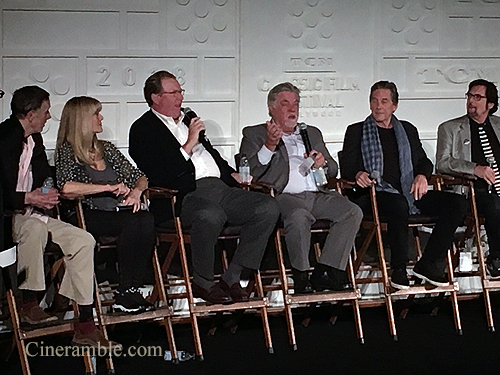
So, there you have my lengthy review of this year’s TCM Classic Film Festival. It’s not much different from previous years, and that’s a good thing. I like that after nearly a decade of running this festival that the TCM crew has managed to run this thing as smoothly as they do in the hectic center of Hollywood where it takes place. I myself have managed to figure out how to make the most of my experience, and this year I managed to break my own record and watch a total of 9 movies. Some were ones that I have seen many times, including all the final shows of the night, but there were a few that were new to me that I’m grateful that I waited for in order to watch them on a big screen. I even shocked myself in realizing that I’ve never watched the entirety of Mr. Smith Goes to Washington, or have missed out on lauded films like Once Upon a Time in the West and Bull Durham. Also, discovering Maurice at this year’s festival was rewarding and has given me a renewed interest in the works of Merchant Ivory. But, what I love best about this festival is getting the opportunity to see the people behind the movies in person before every screening. The fact that TCM can organize the schedules of this many legendary actors and filmmakers over the course of 4 days and many different films is quite astounding. It definitely shows you the quality and pull of the TCM brand that they can attract this much talent into one place. The volunteer staff are always nice and helpful as well. The introduction of the Robert Osborne Award is also a wonderful addition to this year’s event, and I look forward to seeing it become an important tradition continued in the festivals from here out. Next year, TCM Film Fest hits it’s 10 year mark, and I hope to be there for that too, hopefully shattering another personal record and maybe getting into events I hadn’t before been able to in years past. So, here’s to another successful festival this year and once again TCM reminds us all of the importance and wonder of cinema and how special it is to be close to the history of film itself, both in Hollywood and in our homes as well.
